-
Paper Information
- Paper Submission
-
Journal Information
- About This Journal
- Editorial Board
- Current Issue
- Archive
- Author Guidelines
- Contact Us
International Journal of Electromagnetics and Applications
p-ISSN: 2168-5037 e-ISSN: 2168-5045
2019; 9(1): 7-13
doi:10.5923/j.ijea.20190901.02

State of the Art Techniques for Cognitive Radio Antenna Design
Oluwafemi A. Ilesanmi1, Charles U. Ndujiuba1, Olabode Idowu-Bismark1, Oluseun Oyeleke Wikiman2, Sadiq Thomas2, Idris Muhammad3
1Electrical and Information Engineering Department, Covenant University, Ota, Nigeria
2Dept of Computer Engineering, Nile University, FCT, Abuja, Nigeria
3Electrical Department, Nuhu Bamalli Polytechnic, Zaria, Nigeria
Correspondence to: Oluwafemi A. Ilesanmi, Electrical and Information Engineering Department, Covenant University, Ota, Nigeria.
| Email: |  |
Copyright © 2019 The Author(s). Published by Scientific & Academic Publishing.
This work is licensed under the Creative Commons Attribution International License (CC BY).
http://creativecommons.org/licenses/by/4.0/

In this letter, a survey of different recent state of the art techniques that have been deployed in the design of antennas that can perform excellently for cognitive radio application is carried out. Cognitive radio system fundamentals and antenna requirements for its smooth operations are also discussed. The performance of the antennas designed by various techniques in terms of, the radiation pattern, VSWR/Return loss, peak gain, radiation efficiency are discussed. Issues relating to the design techniques and some factors to consider when designing a suitable antenna for cognitive radio system also highlighted.
Keywords: Cognitive Radio, Frequency Reconfigurable, UWB Antenna, Narrow band Antenna
Cite this paper: Oluwafemi A. Ilesanmi, Charles U. Ndujiuba, Olabode Idowu-Bismark, Oluseun Oyeleke Wikiman, Sadiq Thomas, Idris Muhammad, State of the Art Techniques for Cognitive Radio Antenna Design, International Journal of Electromagnetics and Applications, Vol. 9 No. 1, 2019, pp. 7-13. doi: 10.5923/j.ijea.20190901.02.
Article Outline
1. Introduction
- Cognitive radio is an intelligent radio system that has the ability to monitor its environment and based on its idea of sensing and learning from its environment accordingly changes its mode of operation in order to maintain a good quality of service [1]. This will ensure that the system operates in the most suitable mode to achieve power and spectral efficiency under various RF conditions [2, 3]. Cognitive radio system is aimed at ensuring a highly reliable communication and efficient usage of the limited radio spectrum while eliminating overcrowding of some part of the spectrum and underutilization of some by implementing a dynamic spectrum access scheme (DSA). Although there are lot of parameters like: modulation, transmit-power, carrier-frequency, polarization, radiation pattern, that the cognitive radio can change according to the idea of learning and understanding of its environment, but the key parameter requiring changes for cognitive radio system is the operating frequency [1]. This therefore necessitated the need for a reconfigurable antenna.Antenna, been an important component of a cognitive radio system has attracted a lot of interest from researchers both from the academics and the industries because of its complexity. In a cognitive-radio environment, there are two types of users: primary users and secondary users [4, 5]. The primary users have some part of the spectrum or channel already assigned to on a permanent basis and so have the right to freely access it at any point in time. Since primary users are not active all the time, a cognitive-radio system, designed for a more efficient use of spectrum should be able to dynamically assign the free part of the channel to the secondary users. So the antenna used in cognitive radio environment is expected to operate in two states, sensing state and communicating state.Cognitive radio system can operate in two modes, the underlay and the interleave mode [5] depending on the interference tolerant level of the primary users. In the underlay mode, only one UWB antenna with reconfigurable frequency capability is used for sensing the wide spectrum and at the same time for continuous communication since communication in this mode is performed below the noise floor of the primary users, with restriction on their transmission power, which is limited to -40dBm/MHz to avoid interference with the primary users [6]. In the interleave mode, the secondary users can transmit at full power, but only over the white space i.e. over channels that are not currently used by the primary users. The restriction here is on when and where the secondary users can transmit. Therefore, for an antenna to work perfectly well for cognitive radio system, it must be capable of sensing a wide range of frequency and also reconfigure its operating frequency. This paper is arranged as follows: Section I is introduction, section II is a brief description of Antennas for cognitive radio system, section III highlights some of the recent techniques employed in the design of cognitive radio antenna and section IV is the conclusion.
2. Cognitive Radio Antenna
- Cognitive radio system needs a specialized antenna for spectrum sensing and communication. This can be designed in two ways: One, integrating a narrow band antenna into a UWB antenna, where the UWB antenna does the spectrum sensing and the narrow the communication. Secondly, only one UWB antenna can be used to perform both spectrum sensing and communication with the capability of frequency notching and re-configurability. In most of the reported designs, microstrip antenna, planar monopole and slot antennas have been mostly used. For any antenna to be suitable for cognitive radio system, frequency re-configurability is an essential characteristic of such antennas.Basic microstrip antenna design starts from the basic transmission line model as stated in [7, 8]. Since the antenna is expected to cover the UWB range of frequency, the center frequency can be chosen to be 6.85 GHz. These designs mainly involve the design of a conventional antenna whose shape is then modified to achieve the desired objective. This may involve different modifications to the radiating element, the ground plane and the feed structure with parametric optimization to achieve the best result. These modifications such as introducing slots, defected ground, increase substrate height and low dielectric substrate are in a way to increase the impedance bandwidth of the antenna whiles switches are also incorporated to make the antenna frequency tunable. The re-configurability of the antenna makes it suitable for cognitive radio application. Reconfiguration in antennas can be achieved by using electronic switches to alter the effective length of the antenna [9, 10].
3. Reviewed Techniques for Cognitive Radio Antenna Design
- Antenna for cognitive radio application should be able to sense a wide range of frequencies and also should be able to reconfigure its frequency. Commonly used electronic switches for developing frequency-reconfiguration or impedance matching in antennas for wireless applications are, FETS, RF MEMS, VARACTOR Diodes, PIN Diodes and photoconductive switches. Another way of achieving antenna reconfiguration is by using mechanical means. This employs the use of actuators and motors to move a specific part of the antenna resulting in changes in the electrical properties of the antenna by altering its radiating edges, hence reconfiguration of the antenna parameter. In [9], a single UWB antenna capable of frequency reconfiguration by the use of GaAs FET switches and stubs as shown in fig. 1 below was designed for cognitive radio application. The switches were used to connect and disconnect four stubs of different lengths to the main feed line of a circular disc monopole antenna with a partial ground. When all the switches are OFF, the antenna behaves like a UWB antenna, scanning the entire spectrum for holes. Combination of any of the switches in an ON and OFF position reconfigures the antenna frequency for narrow band communication over the channel with 20% increase in the overall gain. This antenna was able to reconfigure to four different frequency bands of: 2.1–2.6 GHz; 3.6–4.6 GHz and a dual band of: 2.8–3.4 GHz and 4.9–5.8 GHz.
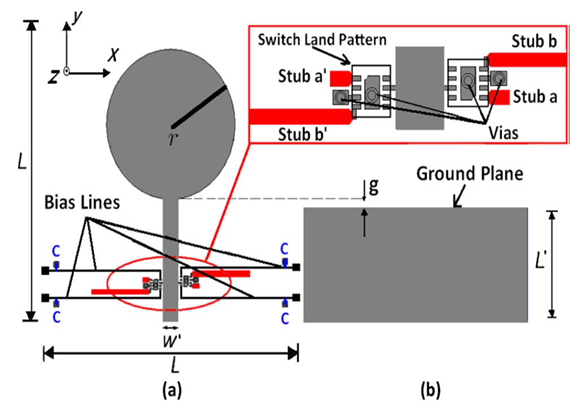 | Figure 1. Configuration of the proposed Reconfigurable UWB antenna, (a) Top view (b) Bottom view [9] |
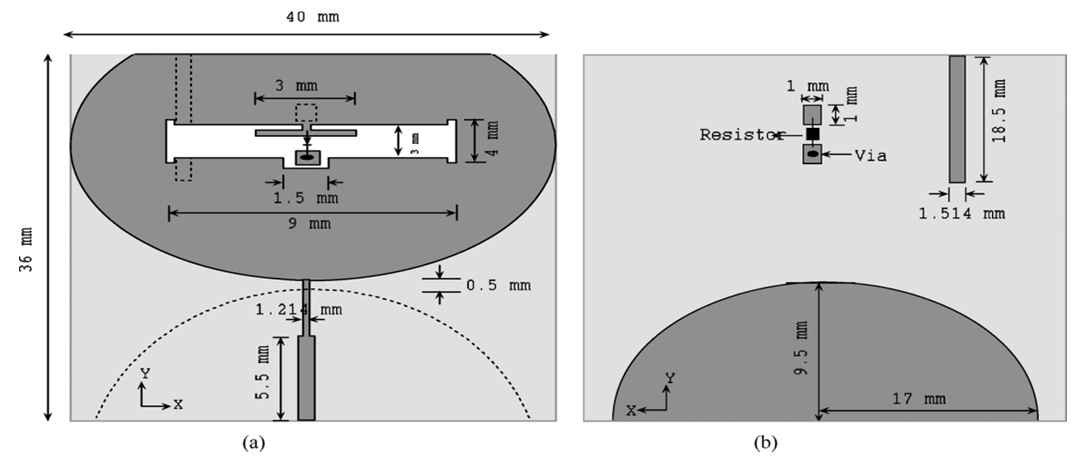 | Figure 2. Configuration of the proposed UWB/Reconfigurable narrowband antenna, (a) Top view (b) Bottom view [10] |
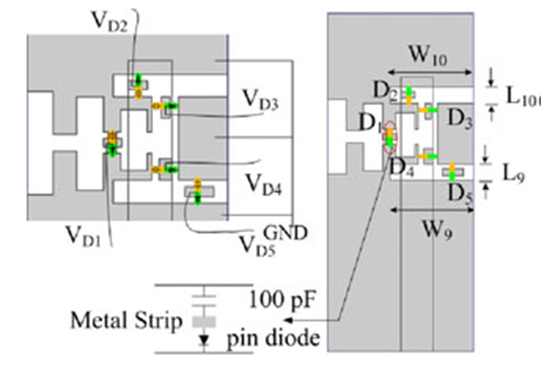 | Figure 3. Proposed reconfigurable slot antenna with diode connections [11] |
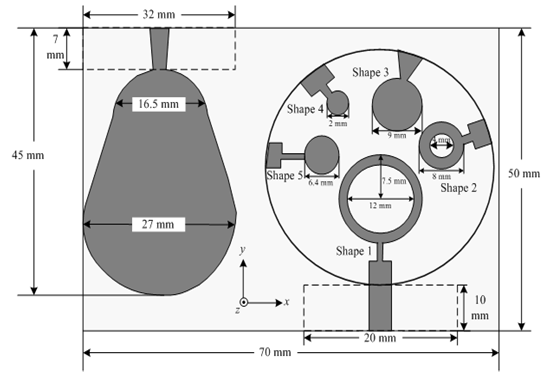 | Figure 4. Antenna Structure [14] |
 | Figure 5. Reconfigurable UWB antenna using OCMS [15] |
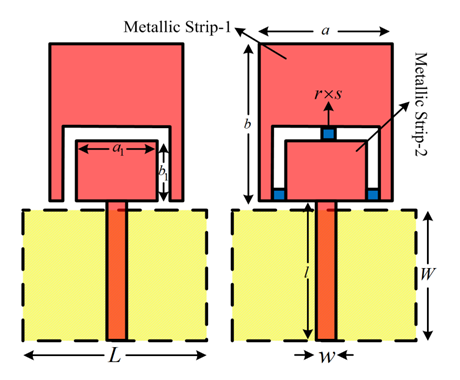 | Figure 6. Reconfigurable UWB monopole antenna [16] |
 | Figure 7. Monopole UWB antenna with two SRRs near the feed line [17] |
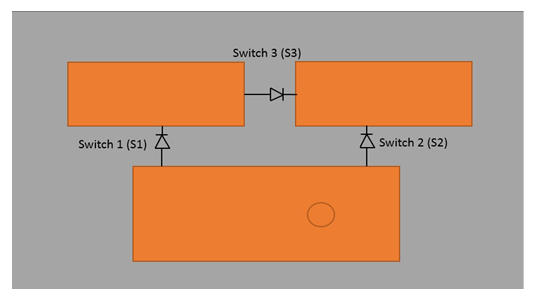 | Figure 8. Schematic diagram of the proposed reconfigurable UWB patch antenna [18] |
 | Figure 9. Hybrid antenna layout [20] |
4. Conclusions
- Cognitive radio is a future technology for effective and spectrum efficient wireless communication which requires a good antenna in its front end. Some of the recent techniques employed in the design of antennas suitable for cognitive radio have been highlighted. Comparatively, most of the designs highlighted in this letter have omnidirectional radiation pattern which is good for cognitive radio system and indoor applications, 2:1 VSWR and efficiency greater than 70%. In some of the designs, size or complexity of the antenna will be an issue for portable wireless devices, while in some mutual coupling between UWB and NB antenna and interference from electronics switches biasing line which can affect the radiation characteristics of the antenna will be an issue. Therefore in choosing the best technique to use, attention must be given to factors like: the compactness, isolation of mutual coupling between ports, isolation of biasing line interference, radiation characteristics, frequency re-configurability and band notching to prevent interference from existing primary users.
 Abstract
Abstract Reference
Reference Full-Text PDF
Full-Text PDF Full-text HTML
Full-text HTML